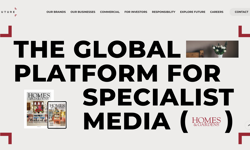Deciding on whether to invest time, effort and money into the German market can be a difficult task for a British publisher. On the surface, there is very little top-level information available. Year-on-year performance data for the overall magazine market is not something that German distributors or publishers can easily get their hands on, and this makes it difficult for a decision based on facts alone to be made. However, in any business, taking risks is part of life and as any publisher already in the German market will tell you, there are substantial benefits to be gained in launching either as an imported title or indeed as a full blown German edition.
Overview
With a population of 82.6 million people, the two biggest problems the German economy has faced in recent years have been unemployment and economic growth. Up until recently, unemployment reached the undesired levels of between 4.2 and 4.6 million people, and, as a result, economic growth had been relatively low (between 1% and 1.2%). However, 2007 proved to be a good year, with unemployment falling to 3.7 million and economic growth increasing to 2.8%. The result of this economic instability on the German magazine market is varied. Between 2005 and 2007, sales of weekly publications declined by 43%, even though the number of new launches in this sector increased by 29%. The fortnightly market, however, rose by 77%, driven mainly by new launches in the TV Guide sector. Monthlies, too, experienced a rise in sales of 16%, again mainly driven by new launches.
Magazine market
There are over 4,000 magazine titles in the German market and that number is growing. Imported titles account for approximately 1.5% of the total market. The largest sector is TV Guides, which accounts for 17%, closely followed by Women’s Interest at 14.5%. These are some way ahead of the next largest sectors, General Interest and Youth titles / Comics, both of which are around 7%.
Three main publishing groups dominate the industry. Axel Springer is by far the biggest and accounts for 27% of the market. Bauer and Gruner + Jahr are second and third respectively with 15.9% and 15.5%. Burda follows behind with 8%. The split between newsstand sales and subscriptions is fairly even. Subscriptions account for 44% of total sales, which is significant in a market of around 119,000 retailers. 41% of sales are generated at newsstand level with the remainder made up of magazine reading clubs and airlines. Sales efficiency levels for domestic press are around 65% with foreign press at a lower level of 46%.
Distribution
The German distribution system is similar to the UK’s in that magazines are distributed to retailers via wholesalers using a national distributor. That however is where the similarity ends. In all other areas, there are significant differences from the UK system of distribution. There are a number of distribution companies in Germany either specialising in national distribution of domestic press or focusing on specialist distribution of imported foreign press. Who to choose depends on the nature of the title and the objectives to be achieved, and publishers should seek advice from their UK distributor before deciding. There are around 75 wholesalers in Germany, each working as monopolists in designated areas. Most of these are family owned and run companies, with some part owned by German publishers. In almost all cases, it is the wholesaler who will determine where copies are placed at retail level. It is also the wholesaler who will determine the level of discount to be applied to each title distributed.
In the main, distributors earn nothing from copy sales. All the revenue goes to the wholesalers. The level of average sales per annum determines the remit a publisher will receive. The higher the average sale the more remit a publisher can expect back. As a result, many distributors charge a distribution fee for every issue distributed which effectively acts as their income. Fees vary, as do how these are calculated. Distribution fees generally do not apply to imported titles but again this really depends on which distributor is used. The major benefit to publishers is that they have the sole right to determine the level of copies distributed into the market. There are no initial barriers to entry and no listings fees at retail level. There is also full transparency of competitive information. Competitive sales analysis is freely available, allowing publishers to determine if a launch is viable and what level to distribute at.
Retail
As previously mentioned, there are approximately 119,000 magazine retailers in the German market. The majority of these are independents, convenience stores, petrol stations and "shop in shops" (small independent outlets located in department stores and supermarkets). There is no dominant retail chain in Germany, and with over 4,000 titles and with publishers determining the level of copy distributed in the market, the main problem is overcrowded shelves and visibility. The one saving grace for publishers in this difficult market is the presence of the 489 key travel points. These include 14 airport travel outlets, the most important of which are located in Frankfurt, Berlin, Munich and Duesseldorf. These travel points are owned and run by approximately 62 separate companies, and although they account for 0.4% of the total make up of German press outlets, they account for 10% of the total press turnover in Germany. Indeed, they also account for 50% of all international press sales. The average number of titles on the travel points’ shelves is approximately 1,000 compared to around 250 for independents. With all year round opening, no barriers to entry and a full assortment of titles being accepted, these outlets are an attractive proposition to any international publisher.
Promotions
Like most other areas of the German press market, the wholesalers control promotional schemes. In the majority of cases, wholesalers will create and run a scheme and publishers will purchase this directly from the wholesaler. With the retail landscape dominated by independents, promotional opportunities are limited and mainly take the form of window and in-store displays. Merchandising schemes are also available whereby merchandisers employed by wholesalers will merchandise titles to ensure visibility and availability. In an overcrowded market, this scheme is popular. There is little co-ordination across the market as each scheme is independently owned and whilst distributors offer limited schemes, it may be best to opt for a more structured offer at the airports and railway stations. Whilst these are more expensive, there is real benefit to publishers in additional awareness.
Local language
Publishers may also wish to consider translating their titles into German, so that they can reach a much larger readership. By producing a local language edition, publishers are treated as a domestic publisher, allowing mass-market distribution, and attracting domestic publisher terms, which can be more favourable than imported press. In addition, German language titles can be distributed to Austria and Switzerland offering additional sales opportunities. Publishers should also take note of the fact that, with 1.7 million Turkish people living in Germany, additional opportunities exist for Turkish language editions. Publishers should be aware, however, that launching a domestic language edition will attract the distribution fee, which must be paid to the distributor for all issues distributed.
Unique
It’s no surprise that the UK has one of the most extensive and unique ranges of magazines in the world. Many topics considered "specialist" in the UK, may have greater appeal in overseas markets and in an overcrowded market such as Germany, distributors and retailers are crying out for innovation.
British publications offer that range of diversity and, over the past twelve months many specialist and mid range titles have succeeded, where the more mainstream and "me too" titles have failed.
Price and VAT
It is important for UK publishers to seek information and advice from their export distributor with regard to pricing their product competitively. VAT on magazines in Germany is 7% and this is added to the eventual selling price. This rises to 16% for adult press. This applies to all magazines sold in Germany, however imported UK publications are still priced much higher than their domestic competitors simply because of the added freight and distribution costs that apply. It is true that imported titles are considered to be premium product and therefore people expect to pay a higher price, however UK magazines can gain readership from other imported and domestic titles, by simply funding a lower, more competitive price. As a price guide, the average price of an imported publication in Germany is around €6.50, whilst a domestic title is usually under €3.00.
Unsolds
Publishers should be aware that German retailers have up to five months from on sale date to return any unsold magazines. This causes some difficulty for publishers wishing to gain a steer on how their magazines are performing issue on issue. On a positive note, however, unsold copies can be collected and retained, unlike the UK market, providing publishers with the opportunity of reusing these old issues for future promotions, such as value packs and 2 for 1’s. There is a small charge for the collection and retention of these unsolds, however the benefit generated from reusing these old copies, far outweighs these costs.
Conclusion
Germany has been through a difficult time with magazine sales in recent years and the situation continues to prove challenging for publishers, however an astute publisher will always succeed with a little innovation and creative thinking. The biggest hurdle is actually getting a magazine seen in an overcrowded market. Retailers are on the lookout for unique publications to freshen up their shelves, and UK publishers are best placed to bring that uniqueness to the market. And once there, they’ll find the full support and co-operation of a distribution channel, eager to take advantage of every single sales opportunity available.
FEATURE
The German Market
A shortage of data and an overcrowded newsstand are two of the challenges facing UK publishers eyeing up the German market. However, a population of 83 million, and German speakers in Austria and Switzerland to boot, is a considerable prize. Paride Forte gives us an overview of the German market.










